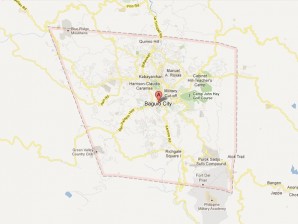
The Baguio police sent a team through these tunnels on Friday to determine whether the underground system has become a security problem, said Insp. Viyo Hidalgo, chief of the city’s tourism police unit and city police spokesperson.
Police recently arrested a suspect in the October break-in at a department store along Magsaysay Avenue. At least four thieves, who took expensive garments from the store, entered the shop’s basement through a 10-meter opening that was made through a section of the old tunnels.
Drilling
Police arrested one of the suspects after security guards in the area alerted authorities about drilling sounds beneath the store.
The tunnels run through the city’s downtown area, serving as channel for runoff rainwater that is discharged into Burnham Park’s man-made lake and toward a creek, city government records showed. Burnham Lake also has a drainage system that discharges excess water toward Kennon Road.
A section of the tunnel runs from Burnham Lake to Magsaysay Avenue, where the Baguio City market and at least 15 establishments, including banks, are located. The shop targeted by thieves last month is three blocks from the lake.
The tunnel ends below the former Philippine Rabbit compound, which has been converted into a parking area after the old bus terminal there collapsed into a sinkhole in the late 1990s because damage to the tunnel had weakened the area’s natural foundations.
Hidalgo said Senior Supt. Jesus Cambay, city police director, ordered policemen to inspect the tunnels and map out sections that thieves may try to use in the future.
Closer look
“The team did not find any evidence suggesting further robbery attempts through the tunnels. We just proceeded to survey and inspect the facility,” Hidalgo said.
He said the tunnels may have been accessed through Burnham Park. Sections of the park are undergoing improvements, and workers have left open certain passageways leading to the tunnels, he said.
Hidalgo said the police were studying similar crimes, believing that the set of skills needed to dig tunnels to get to a target establishment is common to people who have experienced working in small-scale mines.
The tunnels were built in 1908, and were repaired and reinforced by the city government in 2002, after government engineers discovered that the old system was not built to contain stronger rains dumped in the last few years due to extreme weather changes.
The downtown area of this mountain resort city experienced heavy flooding in 1993 due to the onslaught of Typhoon “Goring,” and government engineers then attributed the phenomenon to the outdated drainage system.
Brigida Ancheta, one of the first city engineers to study the old drains in 1993, discovered that sections of the tunnel system were damaged.
In 2001, Typhoon “Feria” again triggered flooding, prompting the government to fund the tunnels’ rehabilitation, Ancheta said.
She said some sections of the city’s tunnels were wide enough to accommodate several people while other sections were narrower, just enough for one person to squeeze through. Vincent Cabreza, Inquirer Northern Luzon